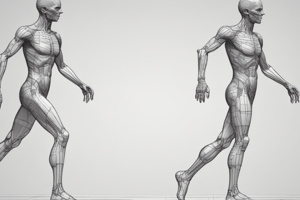Podcast
Questions and Answers
What is the purpose of a hip-leveling guide?
What is the purpose of a hip-leveling guide?
- To assist with donning and doffing procedures
- To manage residual limb
- To analyze gait cycle
- To ensure proper alignment of the prosthesis (correct)
What is the result of excessive inversion or eversion of the foot during gait?
What is the result of excessive inversion or eversion of the foot during gait?
- Misalignment of the prosthesis (correct)
- Enhanced donning and doffing procedures
- Proper alignment of the prosthesis
- Improved residual limb management
What is the ideal knee flexion angle at initial contact during prosthetic gait?
What is the ideal knee flexion angle at initial contact during prosthetic gait?
- 20 degrees (correct)
- 40 degrees
- 10 degrees
- 30 degrees
What is the term for the phase of gait where the heel comes off the ground and the swing foot passes anterior to the stance limb?
What is the term for the phase of gait where the heel comes off the ground and the swing foot passes anterior to the stance limb?
What is the consequence of a socket that is too far inset?
What is the consequence of a socket that is too far inset?
What is the term for the movement of the heel inward during gait?
What is the term for the movement of the heel inward during gait?
What is the consequence of a foot that is too far anteriorly positioned?
What is the consequence of a foot that is too far anteriorly positioned?
What is the term for the phase of gait where the knee moves over the foot and dorsiflexion steadily increases?
What is the term for the phase of gait where the knee moves over the foot and dorsiflexion steadily increases?
What is the primary cause of medial whip in a transfemoral amputee?
What is the primary cause of medial whip in a transfemoral amputee?
During the terminal stance phase of the gait cycle, what occurs in a normal transfemoral gait?
During the terminal stance phase of the gait cycle, what occurs in a normal transfemoral gait?
What is a common gait deviation associated with an unstable prosthetic knee during the stance phase?
What is a common gait deviation associated with an unstable prosthetic knee during the stance phase?
What can cause excessive knee flexion and heel rise in early swing phase?
What can cause excessive knee flexion and heel rise in early swing phase?
What is a common cause of drop-off in transfemoral amputees?
What is a common cause of drop-off in transfemoral amputees?
What is the primary cause of lateral whip in a transfemoral amputee?
What is the primary cause of lateral whip in a transfemoral amputee?
What is a common gait deviation associated with hip extensor weakness?
What is a common gait deviation associated with hip extensor weakness?
What can cause excessive pressure in the perineum during the stance phase?
What can cause excessive pressure in the perineum during the stance phase?
During the bench alignment of a transtibial prosthesis in the sagittal plane, the plumb line should pass through which of the following points?
During the bench alignment of a transtibial prosthesis in the sagittal plane, the plumb line should pass through which of the following points?
In the coronal plane, the socket of a transtibial prosthesis is placed in how much varus (adduction) to protect the head of the fibula?
In the coronal plane, the socket of a transtibial prosthesis is placed in how much varus (adduction) to protect the head of the fibula?
During gait cycle analysis of a transfemoral prosthesis, what is the primary aim of socket adjustment in the anterior view?
During gait cycle analysis of a transfemoral prosthesis, what is the primary aim of socket adjustment in the anterior view?
During dynamic alignment of a transtibial prosthesis, what is the recommended base of support width?
During dynamic alignment of a transtibial prosthesis, what is the recommended base of support width?
In the sagittal plane, the socket of a transtibial prosthesis is aligned with the knee flexed at what angle?
In the sagittal plane, the socket of a transtibial prosthesis is aligned with the knee flexed at what angle?
During dynamic alignment of a transfemoral prosthesis, what is the primary goal of gait cycle analysis?
During dynamic alignment of a transfemoral prosthesis, what is the primary goal of gait cycle analysis?
During bench alignment of a transtibial prosthesis in the coronal plane, what is the recommended foot position?
During bench alignment of a transtibial prosthesis in the coronal plane, what is the recommended foot position?
During static alignment of a transfemoral prosthesis, what is the recommended way to observe changes in length with weight bearing?
During static alignment of a transfemoral prosthesis, what is the recommended way to observe changes in length with weight bearing?
Flashcards are hidden until you start studying
Study Notes
Hip-Leveling Guide
- A device that uses a bubble level to determine if the pelvis is level
Dynamic Alignment
- Walking in a safe environment, often using parallel bars, to identify and correct gait deviations
- Aims to achieve a more efficient gait technique
Prosthetic Gait - Transtibial
- Initial contact: lateral border of heel, knee flexed by 20°
- Loading response: medial aspect of forefoot touches ground, medial border of foot parallel to line of progression
- Midstance: dorsiflexion increases, knee moves over foot
- Pre-swing: heel comes off ground, prosthesis rolls forward over toe, and lifts off ground
- Sufficient ground clearance is required
Gait Deviations - Transtibial
- Excessive inversion or eversion of foot: misalignment of prosthesis
- Excessive knee flexion: foot too far posterior, too dorsiflexed, or heel too rigid
- Insufficient knee flexion: knee fully extended at heel strike, heel too soft, or foot too far anterior
- Excessive varus: socket too far inset, foot too outset, or excessive external rotation
- Foot excessive internal rotation: socket excessively adducted
Gait Phases - Transtibial
- Initial contact:
- External rotation: foot too far outset or excessive toe-out
- Internal rotation: excessively inset or internally rotated foot
- Midstance:
- Abducted gait: lateral trunk bending, lateral gapping of socket
- Choppy or segmented midstance: differences in flexibility, lack of stability
- Swing phase:
- Insufficient ground clearance/toe-drag: faulty suspension, plantar flexed foot
- Medial whip: misalignment of knee axis, irregular loading of limb
- Climbing hill/ramp:
- Drop off: excessive descent of center of mass, diminished heel rise
- Early heel off: pelvic rise, foot too plantar flexed, toes too stiff
Prosthetic Gait - Transfemoral
- Initial contact: heel, compression of prosthetic heel simulates loading response
- Midstance: weight bearing forces move anteriorly to medial forefoot
- Terminal stance: foot prosthetic simulates toe extension and heel rise
- Pre-swing: individual rolls over toe and moves into knee flexion for effective limb clearance
Gait Deviations - Transfemoral
- Unstable prosthetic knee during stance phase: hip extensor weakness, hip flexion contracture
- Lateral trunk bending: excessive pressure in perineum
- Excessive knee flexion/heel rise in early swing: delays extension, lateral whip
- Medial whip: foot swing in medial arc, excessive external rotation
- Improper donning or suspension: vaulting, too long prosthesis
Bench Alignment - Transtibial
- Side view (Sagittal plane):
- Plumb line passes through anatomic knee center and junction point of posterior third and anterior 2/3 of foot
- Socket aligned with knee flexed 5° to 10° to facilitate heel strike and place quadriceps on stretch
- Foot position: center of heel and big toe aligned along line bisecting socket from anterior view
- Anterior view (Coronal plane):
- Plumb line passes through mid-patella and center of heel
- Socket placed in 2° to 5° of varus (adduction) to protect head of fibula and encourage lateral shift
- Foot externally rotated by 3° to 5° for smooth rollover from heel to toe
Dynamic Alignment - Transtibial
- Smooth rollover from heel to toe with good control of knee
- Consistent base of support width: 5-10 cm
- Toe clearance in swing phase
- Comfortable weight bearing on prosthesis
- Level hips
- Equal and adequate step length
Bench Alignment - Transfemoral
- Aims:
- Stability in double-limb stance
- Adequate lateral shift in single-limb stance
- Narrow base of support (5 cm)
- Anterior view:
- Socket adjusted with hip in 2° to 5° of adduction according to length of femur and strength of hip muscles
Studying That Suits You
Use AI to generate personalized quizzes and flashcards to suit your learning preferences.





